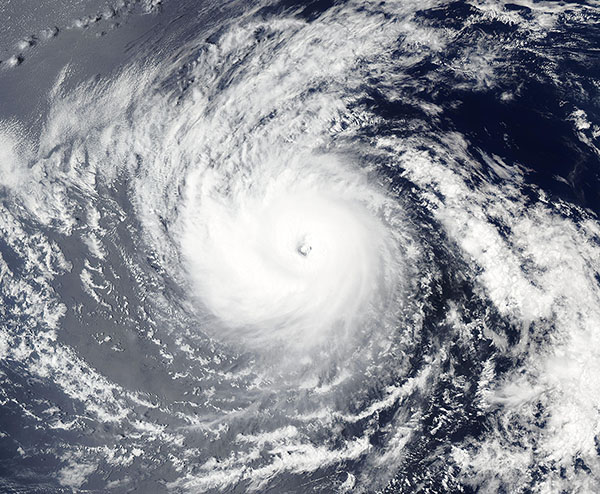Images
August 25, 2024 - Hurricane Gilma
Tweet
On August 22, 2024, the Moderate Resolution Imaging Spectroradiometer (MODIS) on NASA’s Aqua satellite acquired this true-color image of Hurricane Gilma hurtling over the Pacific Ocean towards Hawaii.
According to the National Hurricane Center (NHC), at 2100 UTC (5:00 p.m. EDT) Gilma was carrying maximum sustained winds of 125 miles per hour (205 km/h), placing it at Category 3 on the Saffir-Simpson hurricane wind scale. The center of the storm was located about 160 miles (1,705 km) west-southwest of the southern tip of Baja California and about 1,980 miles (3,185 km) east of Hilo, Hawaii. Gilma was moving west-northwest at 7 miles per hour (11 km/h).
Gilma experienced unfavorable conditions throughout August 23 and wind speeds dropped to 90 miles per hour (145 km/h), which is Category 1 strength. But Hurricane Gilma fought back, rapidly intensifying on August 24 to return to Category 3 status, with maximum sustained winds once again 125 miles per hour (205 km/h).
Despite the rapid intensification, the NCH predicts that gradual weakening is expected to begin on August 25, but Gilma is expected to remain a hurricane into early next week. After that, steady weakening is expected. Current models show that only remnants of this storm should remain as it nears Hawaii.
The Islands expect more impact from another system, Tropical Storm Hone, which is expected to pass near the Big Island of Hawaii August 24-25 carrying maximum sustained winds of about 70 miles per hour (113 km/h). Steady rain has already begun to impact parts of Hawaii on August 24 as Hone approaches and is expected to intensify, possibly triggering flooding. Hawaii County was under a Tropical Storm Warning on August 24 and residents of east-facing coastlines have been warned of extremely high swells and rip currents as the storm passes offshore.
Image Facts
Satellite:
Aqua
Date Acquired: 8/22/2024
Resolutions:
1km (461.8 KB), 500m (1.3 MB), 250m (3 MB)
Bands Used: 1,4,3
Image Credit:
MODIS Land Rapid Response Team, NASA GSFC
Tweet
On August 22, 2024, the Moderate Resolution Imaging Spectroradiometer (MODIS) on NASA’s Aqua satellite acquired this true-color image of Hurricane Gilma hurtling over the Pacific Ocean towards Hawaii.
According to the National Hurricane Center (NHC), at 2100 UTC (5:00 p.m. EDT) Gilma was carrying maximum sustained winds of 125 miles per hour (205 km/h), placing it at Category 3 on the Saffir-Simpson hurricane wind scale. The center of the storm was located about 160 miles (1,705 km) west-southwest of the southern tip of Baja California and about 1,980 miles (3,185 km) east of Hilo, Hawaii. Gilma was moving west-northwest at 7 miles per hour (11 km/h).
Gilma experienced unfavorable conditions throughout August 23 and wind speeds dropped to 90 miles per hour (145 km/h), which is Category 1 strength. But Hurricane Gilma fought back, rapidly intensifying on August 24 to return to Category 3 status, with maximum sustained winds once again 125 miles per hour (205 km/h).
Despite the rapid intensification, the NCH predicts that gradual weakening is expected to begin on August 25, but Gilma is expected to remain a hurricane into early next week. After that, steady weakening is expected. Current models show that only remnants of this storm should remain as it nears Hawaii.
The Islands expect more impact from another system, Tropical Storm Hone, which is expected to pass near the Big Island of Hawaii August 24-25 carrying maximum sustained winds of about 70 miles per hour (113 km/h). Steady rain has already begun to impact parts of Hawaii on August 24 as Hone approaches and is expected to intensify, possibly triggering flooding. Hawaii County was under a Tropical Storm Warning on August 24 and residents of east-facing coastlines have been warned of extremely high swells and rip currents as the storm passes offshore.
Image Facts
Satellite:
Aqua
Date Acquired: 8/22/2024
Resolutions:
1km (461.8 KB), 500m (1.3 MB), 250m (3 MB)
Bands Used: 1,4,3
Image Credit:
MODIS Land Rapid Response Team, NASA GSFC




